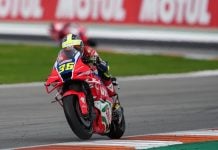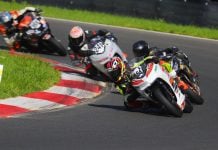AMA Pro Racing Special Projects Manager Bill Syfan, the man in charge of the AMA Superbike event at Road Atlanta, held a press conference Saturday afternoon to shed some light on what has been going on with the sanctioning body’s inspections and rulings on the crankshafts of Mat Mladin and Tommy Hayden. Here is the word-for-word transcription of that press conference: Bill Syfan: DMG decided to bring everybody up to speed on where we’re at with what’s happened over the last two weeks with Suzuki crankshafts. It’s all in the interest of transparency. There’s a lot of rumors out there that this is politically motivated. That’s not true. It’s certainly easy to connect the dots, but it’s just not true. So what’s I’m going to read is a timeline on the Suzuki crankshaft situation. I’ll take some questions at the end, but more than likely I won’t be able to answer them if they get into too much detail, but this should help clear things up. Following the Superbike race on Sunday, August 17, as you know, the three Yosh [Rockstar Makita Yoshimura] Suzukis of #1, #6 and #22 were impounded for routine post-race inspection. Chief Tech Inspector Jim Rashid asked for intake and exhaust valves from all three machines. He also requested to inspect the crankshaft on one of the bikes and chose the #6 Suzuki bike since it was the winner of the race. On initial comparison of the #6 Suzuki crankshaft to the homologated control unit/crankshaft, removed from a complete 2007 Suzuki GSX-R1000 provided by American Suzuki, that is the homologated motorcycle (The crankshaft was removed from it), Jim [Rashid] noticed several differences including the date of manufacture marking system, the difference in how the journal bearing codes were engraved, the crankshaft journal oil holes and the surface texture and the darkness of the #6 crankshaft. The two parts were shown to Yoshimura Team Manager Don Sakakura at the track. He was informed that the #6 Suzuki crankshaft would be transported to the current AMA Pro Racing Tech department in Pickerington, Ohio for further detailed inspections and measurements. To provide for maximum fairness during the additional inspections AMA Pro Racing requested six additional crankshafts, two from each of American Suzuki’s three parts warehouses, be shipped to Pickerington. The #6 Suzuki crankshaft and the homologated control crankshaft were packaged securely at the track and arrived safely in Pickerington offices on Tuesday, August 19. On Wednesday, August 20 two GSX-R1000 crankshafts were received at the Pickerington offices from the American Suzuki parts warehouse in Brea, California. When Don Sakakura was called to find out the timing of the other crankshafts being shipped, Don said he misunderstood the quantity needed. The two crankshafts from the Brea warehouse were unpacked and placed alongside the control crankshaft and the #6 Suzuki crankshaft. Visually the two Brea crankshafts matched the control crankshaft in every way except dates of manufacturer etched into the far right counterweight, the Brea crankshafts being 2008 models compared to the 2007 control part. After his initial inspection at Pickerington, Jim [Rashid] called Don [Sakakura] to tell him that no additional crankshafts would be needed. During the afternoon of Wednesday, August 20 inspections of all four crankshafts were made by seven different AMA officials, including myself. I was there for some transition meetings of the Pickerington-to-Daytona thing. Jim took measurements and weights of all four crankshafts. Based on these thorough inspections the following differences were noted between the #6 Suzuki crankshaft and the homologated crankshaft: 1. The #6 Suzuki crankshaft has no manufacture date etched into the far right hand #4 connecting rod counterweight, as evident on the other three control parts. It contains only the number 242, that’s ‘no. 242′ stamped in ink on the counterweight in the same basic location. The bearing codes are laser etched on a different weight than the three control parts, which are mechanically etched on the three control parts. 2. On the control part and two additional sample parts all have consistent significant chamfering on the oil delivery holes. The #6 Suzuki crankshaft had no chamfering on any of the crank bearing or rod bearing oil delivery holes. 3. The crankshaft from the #6 Suzuki was much darker in color than the three control parts with a smoothness and texture not found on the other three. The consistent sharp edges found on the three control crankshafts are smooth on the #6 Suzuki crankshaft. Based on the various findings above, it was a unanimous decision that the #6 Suzuki crankshaft differed significantly from the homologated control crankshaft and the two additional production crankshafts provided by American Suzuki. The #6 Suzuki crankshaft is out of specification as compared to the homologated parts and is deemed out of compliance. Therefore the decision was made to disqualify Mat Mladin, the rider of the #6 Suzuki from Saturday and Sunday’s Superbike races. Now that’s something that’s in the current rulebook. It says that if you have any mechanical infractions it will apply to all events during that meet. So this is like 1937 dirt track, but that’s the way the rulebook reads and we’re trying to follow the rulebook to the tee. Then we come to yesterday. Following Group A Superbike qualifying at Road Atlanta the Yoshimura Suzukis of #1, #6 and #22 were impounded for routine post-qualifying inspections. Following the removal of the left-hand engine covers Tech inspectors noted that the crankshafts in the #6 and the #22 Suzukis were the same as the non-homologated part from VIR. The crankshaft from the #1 Suzuki matched the homologated crankshaft. The two non-homologated crankshafts were inspected, and the following differences were noted: 1. The crankshaft on the #6 Suzuki matches the non-homologated parts in every way listed above with the exception of the bearing codes are hand-engraved. And they weren’t done by a machine. They were done by hand. 2. The crankshaft on the #22 Suzuki matches the non-homologated part in every way with the exception that it has no bearing codes whatsoever. If this is a production part as claimed it would be extremely difficult for a dealer receiving this crankshaft to put in a customer’s bike without the bearing codes. These two crankshafts will be kept in AMA Pro Racing’s possession until the appeal is finalized. A side note: the other six privateer Suzukis, we’re talking about the three from Group B yesterday and the three from Group B today, all had homologated crankshafts. Per the rulebook only a homologated crankshaft is permitted. That’s it. Question: Did you look at the bikes after qualifying this morning? Syfan: Yes. They all had homologated crankshafts in them. Q: How was that determined? Syfan: By pulling the left-hand engine cover. Q: So then only the number on the left-side counterweight was visible? Syfan: The telltale signs from pulling the left-hand engine case is the color of the crankshaft and the production code that is mechanically etched in on the homologated crankshafts. Q: How did AMA Pro Racing determine these non-homologated crankshafts enhanced performance? Syfan: We’re not making any claims to that, in that respect. These crankshafts do not match the homologated unit. Q: So is this a Category One [more serious] or a Category Two [less serious] violation? Syfan: It falls under Category One. We have our theories on it, and we’ll present those at the appeal. That’s not something I can talk about right now. Q: Were the cases sealed today or yesterday? Syfan: Ben Spies’ motor was sealed from yesterday’s Group A qualifying. All three engines were sealed from today’s Group A qualifying. Q: Has Suzuki been told everything you told us? Syfan: Yes. Q: So they know what the infractions are? Syfan: Yes. Q: You mentioned the color of the crank. What does that mean? Syfan: We don’t know. We have our theories, again. Q: Surface treatment or a different grade? Could it be any of those things? What are the things it could be? Syfan: We’re not sure. Q: Has the metal composition of the non-homologated crankshaft been tested in a lab yet? Syfan: No. Q: Are there plans to test the metal composition of the crankshaft? Syfan: I can’t say. Q: What’s the status of the appeal? Syfan: Don Sakakura, the Team Manager for Yoshimura, received instruction today. This is the information that they need to move forward and provide us with more information. This would be called, I guess, the actual, the more detailed appeal. Up until today they didn’t have clear instructions on what they needed to provide by next Friday. Q: They were told all this stuff today? Syfan: Yes. Q: So they didn’t know any of this before today? Syfan: Well, the discussion started yesterday. Q: But they didn’t have all of the specifics until today? Syfan: Correct. Q: So what’s next Friday? Syfan: Well, that’s the end of the 14-day period as noted in the rulebook. Q: So he needs to have what to you at the end of that period? Syfan: He needs to provide to us production records for these crankshafts, vendor information and the VIN range of the motorcycles that they went in. that’s Part A. Part B is they have to provide a motorcycle in that VIN range whether it’s new or used and have it disassembled with an AMA official there. Q: That would show a crank with weird numbers or matching numbers to that crank? Syfan: They have to prove to us that those are production parts. It’s as simple as that. American Suzuki and Yoshimura Suzuki have to prove to us that those are production parts. Q: So the appeal then, they can file it, then how long do you have before you accept it? Syfan: I don’t think the rulebook is clear on that, but obviously we want this to be wrapped up as soon as possible. This is not good for anybody. These are great riders. Yoshimura is a great team. This is just an unfortunate situation for the whole paddock and the series. Q: Who made the decisions on this stuff? Is it made by you or Colin [Fraser] or Roger [Edmondson]? Syfan: It was a group decision. Q: So they were all informed the whole time? Syfan: Absolutely. Everybody was onboard with all of this. Q: You called yesterday’s post-qualifying inspections ‘routine.’ When was the last time that after provisional Superbike qualifying bikes had their engine case covers taken off? Syfan: I couldn’t tell you, but certainly with the situation at hand it’s pretty obvious that we weren’t necessarily looking for something but that was an easy check to see what we could see. And unfortunately we found more non-homologated crankshafts.
AMA Pro Racing States Its Case Against Mladin, Tommy Hayden
AMA Pro Racing States Its Case Against Mladin, Tommy Hayden
© 2008, Roadracing World Publishing, Inc. From a press release issued By David Swarts.






